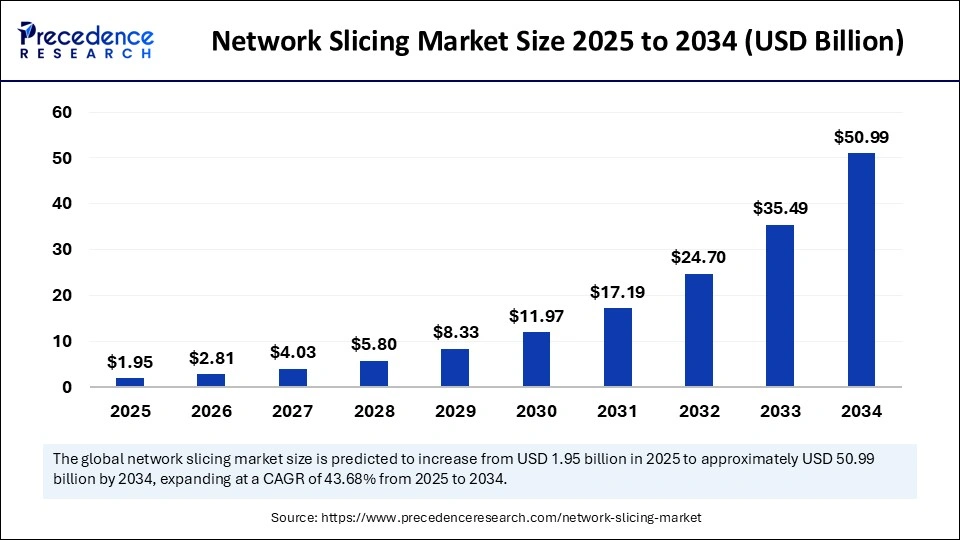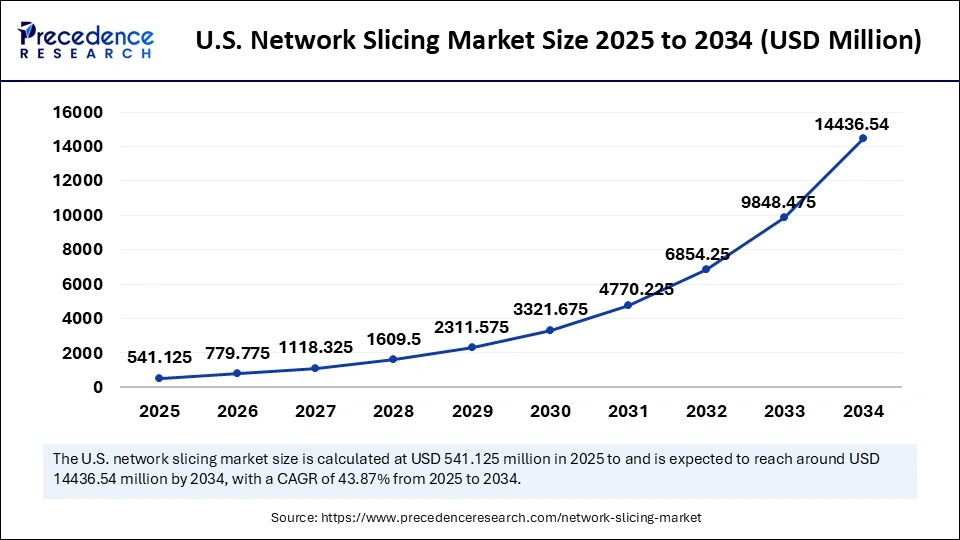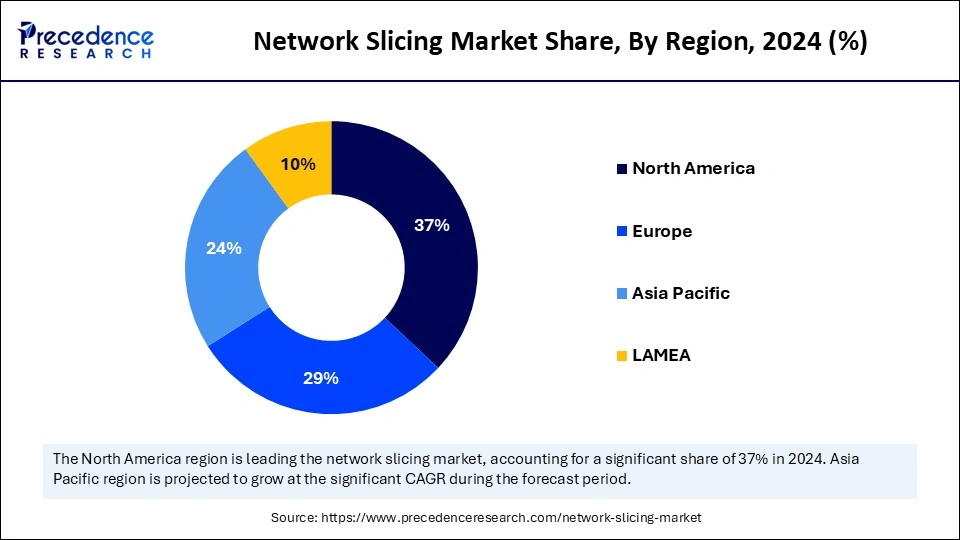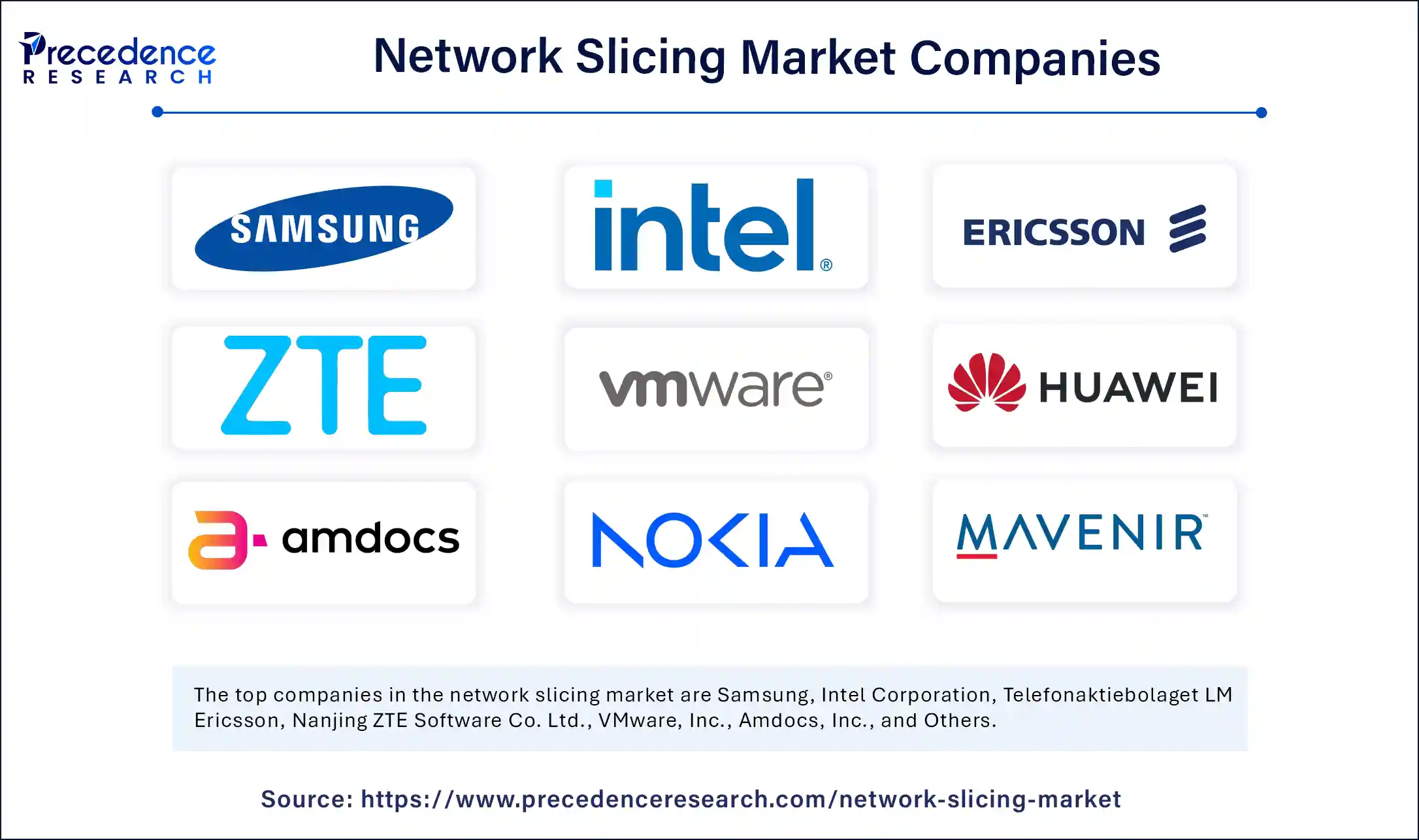List of Contents
Network Slicing Market Size and Forecast 2025 to 2034
The global network slicing market size accounted for USD 1.36 billion in 2024 and is predicted to increase from USD 1.95 billion in 2025 to approximately USD 50.99 billion by 2034, expanding at a CAGR of 43.68% from 2025 to 2034.The increased use of 5G technology and the need for customized network solutions drive the growth of the network slicing market. Moreover, the rising use of IoT devices supports market growth.

Network Slicing Market Key Takeaways
- In terms of revenue, the network slicing market is valued at $1,950 million in 2025.
- It is projected to reach $50,990 million by 2034.
- The market is expected to grow at a CAGR of 43.68% from 2025 to 2034.
- North America dominated the network slicing market with the largest revenue share of 37%in 2024.
- Asia Pacific is expected to grow at the fastest CAGR from 2025 to 2034.
- By enterprise size, the large enterprises segment held the major revenue share in 2024.
- By enterprise size, the small and medium enterprises segment is projected to grow at a significant CAGR during the forecast period from 2025 to 2034.
- By end-user, the healthcare segment led the market by holding more than 23% of revenue share in 2024.
- By end-user, the media & entertainment segment is likely to expand at the highest CAGR in the coming years from 2025 to 2034.
How is AI Transforming Network Slicing?
Artificial Intelligence is playing a crucial role in transforming network slicing by providing predictive analysis, security management, service differentiation, and resource optimization. AI-enabled network slicing has gained 40% better resource utilization compared to traditional approaches. AI is expected to manage network security operations autonomously by up to 75% by 2025.
Companies have implemented AI-driven network slicing in resource utilization, with an efficiency of up to 40% in early trials, unlocking potential opportunities for network slicing and 6G networks. Additionally, companies are focusing on empowering AI-enabled network slicing in the telecommunications sector to boost the quality of services and enable premium services for enterprise customers.
- In February 2025, BubbleRAN and its partner Telenor Research & Innovation demonstrated the world's first AI-driven 5G Intelligent Network slicing at MWC 2025 Barcelona. The network is designed to enhance the connectivity of maritime communication with intelligent, adaptive, and efficient private 5G solutions.(Source: https://techafricanews.com)
U.S. Network Slicing Market Size and Growth 2025 to 2034
The U.S. network slicing market size was exhibited at USD 3.80 million in 2024 and is projected to be worth around USD 14.44 million by 2034, growing at a CAGR of 43.87% from 2025 to 2034.

North America's Sustain Dominance in the Network Slicing Market
North America dominated the market for network slicing with the largest share in 2024, driven by heightened adoption of 5G technology and the presence of key market players. Companies in the region are increasingly investing in 5G network management services. North America has a strong 5G infrastructure, which bolstered the growth of the market. There is a high demand for customized network solutions in industries like healthcare, entertainment, and manufacturing, driving the adoption of network-slicing services. Investments by companies in adoption and innovation in the network slicing space are expected to sustain the long-term growth of the market in North America.
How Does the U.S. Lead the North American Network Slicing Market?
The U.S. leads the network slicing market within North America due to its robust 5G infrastructure. The country's high investment in public safety is expanding the development of advanced network-slicing services. For instance, Verizon's "Enhanced Video Calling", powered by 5G standalone (SA) technology slice off a dedicated chunk of its network resources for Apple iPhones and public safety customers. (Source: https://www.lightreading.com)
The U.S. has a well-established telecom industry, supporting the growth of the market. The telecom industry of the U.S. is projected to witness significant transformation under Donald Trump and a Republican-led Federal Communications Commission (FCC), as the FCC targets spectrum access expansion, reforms to the Universal Service Fund (USF), and investment in streamlined infrastructure. Additionally, the U.S. government's Rip-and-Replace, telecom security program is expected to accelerate industry-wide changes. (Source: https://www.forbes.com)

Asia Pacific: The Fastest-growing Region
Asia Pacific is anticipated to grow at the fastest rate over the forecast period, due to the increase in the adoption of 5G technologies. The region is developing network infrastructure, fostering market growth. Government support in infrastructure development and digital initiatives is accelerating the adoption of network slicing in the region. Companies are focusing on advancing network slicing with API-enabled, zero-touch, self-service, and delivering a real-time solution for ordering and assured communication services for enterprises across the region.
China's Industrial Digitalization to Foster Adoption of Network Slicing
China is a major player in the network slicing market within Asia Pacific. Rising government initiatives to promote the adoption of 5G technologies and support industrial digitalization contribute to market expansion. The rapid growth of a digital-savvy population increases the need for 5G network slicing to empower data-intensive services. There is a strong focus on technological advancements, robust investment in AI-driven network management, and various smart city projects are boosting the adoption of network slicing in China.
Indian Network Slicing Market Trends
India is a significant player in the Asia Pacific network slicing market. The rapid expansion of the telecommunications industry is a key factor supporting the growth of the market in India. Companies like Reliance Jio, Vodafone-Idea, and Bharti Airtel largely account for wireless subscriptions. The proliferation of 5G technology and the Indian government's initiatives to promote digitization contribute to market growth.
- In March 2025, the Department of Telecommunications (DoT) launched the 5G Innovation Hackathon 2025, a six-month initiative for accelerating the development of innovative 5 G-powered solutions designed to resolve industrial and social challenges. The hackathon initiatives are targeting AI-driven network maintenance, internet of things IoT-enabled solutions, 5G broadcasting, agriculture, smart health, industrial automation, non-terrestrial networks (NTN), V2X, D2M, and quantum communication, and key 5G applications.(Source: https://www.pib.gov.in)
Exploring the Growth Potential of Europe in the Network Slicing Market
Europe is considered to be a significantly growing area, driven by early adoption of 5G technology, robust telecommunications infrastructure, government support for digital transformation, and the existence of key market vendors. The government of Europe is investing heavily in 5G infrastructure and network-slicing solutions. Countries like the UK, Germany, and France are leading regional markets due to 5G adoption, a strong telecom industry, and the presence of key market players like Deutsche Telekom, Vodafone, Orange, and Bouygues Telecom. These telecom operators are investing heavily in network infrastructure, opening up new avenues for market growth.
Market Overview
The global network slicing market has been witnessing significant growth, driven by increased use of IoT devices, 5G technology, and cloud services, especially in industries like telecommunication, healthcare, entertainment, retail, and e-commerce. The rising need for high-performance, high-speed, and customized network solutions is fostering the adoption of network-slicing solutions. Additionally, the integration of Software-defined networking (SDN) and network function virtualization (NFV) has increased demand for network slicing to manage network traffic flows. The growing IoT, M2M communications, telemedicine, automation, and streamlining are rapidly adopting network slicing to enable efficient network management, real-time collaborations, production optimization, and high-quality broadcast, live, and video streaming. Additionally, there is a strong focus on strengthening public safety solutions, including security and payment networks, which is creating the need for network slicing.
BT Group's network slicing, launched in September 2024, reached a major milestone as the first-ever real-world leverage of 5G Standalone (SA) network slicing capabilities on the EE mobile network in January 2025. The technology offers fast and more reliable mobile payments in the bustling Lavery's Beer Tent, ensuring accuracy by improving speed and reducing latency and congestion.(Source: https://www.capacitymedia.com)
- In May 2025, Singtel made an enterprise-only service available to 1.5 million consumers. To automatically upgrade to 5 G+ services. The initiative has made Singapore the first country to offer a nationwide 5G SA network slicing. The company has given wide coverage across the island to prioritize customer care, real-time threat protection, fast speeds, and higher security benefits. The company supports Singapore's Smart Nation goals. (Source: https://www.rcrwireless.com)
What are the Growth Factors of the Network Slicing Market?
- Adoption of 5G Technology: The adoption of 5G technology has increased to provide customized network services, driving the adoption of network slicing solutions.
- Adoption of IoT Devices and Applications: The increased adoption of IoT devices and advanced applications has raised the demand for network slicing to enable low latency, reliable communication, and optimal connectivity.
- High-Speed Network Coverage: The demand for high-speed network coverage has increased among industries like automotive, AR/VR, and media & enterprises, driving the need for network slicing.
- Adoption of Cloud Services: The demand for network slicing has increased to meet the need for dedicated and optimized network resources for reliable and high-performance connectivity, driven by the rapid adoption of cloud services.
- Industrial Demands: The demand for network slicing has increased in various industries like healthcare, manufacturing, transportation, and entertainment due to the high adoption of 5G networks across these industries.
Market Scope
| Report Coverage | Details |
| Market Size by 2034 | USD 50.99 Billion |
| Market Size in 2025 | USD 1.95 Billion |
| Market Size in 2024 | USD 1.36 Billion |
| Market Growth Rate from 2025 to 2034 | CAGR of 43.68% |
| Dominating Region | North America |
| Fastest Growing Region | Asia Pacific |
| Base Year | 2024 |
| Forecast Period | 2025 to 2034 |
| Segments Covered | Enterprise Size, End-user, and Region |
| Regions Covered | North America, Europe, Asia-Pacific, Latin America, and Middle East & Africa |
Market Dynamics
Drivers
Demand for High-Speed and Reliable Connectivity
The demand for high-speed and reliable connectivity has increased due to the growing need for low-latency networks, adoption of IoT devices, demand for high-quality video streaming, and expanding 5G infrastructure, driving the network slicing market. Smart cities, industrial IoT, and healthcare have raised the requirement for reliable and high-speed network coverage, driving the adoption of network slicing to enable specialized and efficient networks. Network slicing enhances network performance, user experiences, efficient network management, and operational efficiency and reduces cost. Gaming, manufacturing, healthcare, and media & enterprise industries are the major adopters of network slicing for high-speed and reliable networks.
Restraint
Cybersecurity Concerns
Cybersecurity concerns are restraining the growth of the network slicing market. Network slicing creates various virtual networks, leading to increased vulnerability to cyberattacks. The lack of isolation in network slicing leads to vulnerabilities like unauthorized data access and denial-of-service attacks. The data transmitted privacy and security over sliced networks is a major concern. Lack of standardization, network intrusion, and data breaches are the major cybersecurity concerns that can occur over a sliced network. These concerns prompt regulatory compliance, which can hamper innovation and adoption of network-slicing solutions.
Opportunity
Demand for Customized and Specialized Network Capabilities
Industries like healthcare, automotive, and manufacturing are driving the demand for customized and specialized network capabilities, driven by unique network requirements like high security, low latency, and guaranteed quality of services (QoS). The need for a network with priority of security and latency has increased among industries, driving demand for network slicing to meet their specific business needs. Network slicing enables customized network solutions for specific industry requirements. Network slicing enables specialized network capabilities like integration of network function virtualization (NFV) and software-defined networking (SDN) to design customized network solutions.
By Enterprise Size Analysis
Why Did Large Enterprises Dominate the Network Slicing Market in 2024?
The large enterprises segment held the major share of the network slicing market in 2024. This is mainly due to high adoption of 5G and IoT technologies in large enterprises. Large enterprises adopt those technologies for customer services and operational efficiency, driving the need for network slicing services. Large enterprises have extensive network infrastructure, high IT budgets, and a scalable need for advanced technologies, driving demand for cutting-edge network slicing services to enhance reality, scalability, and speed of various applications across the enterprise.
The small & medium enterprises segment is projected to grow at a significant CAGR during the forecast period due to increased adoption of customized network solutions. SMEs are increasingly adopting 5G technologies. The rising digital transformation and the need for efficient network management solutions are driving demand for advanced network slicing in small & medium enterprises.
By End-user Analysis
Why Did the Healthcare Segment Lead the Network Slicing Market in 2024?
The healthcare segment dominated the network slicing market with the largest share in 2024. This is mainly due to the increased need for efficient healthcare systems. The rising adoption of digital technologies, demand for telemedicine, and need for data security across robust healthcare network security solutions are driving the adoption of network slicing services in healthcare. Government initiatives in promoting digitalization in the healthcare sector are further fueling the adoption of digital healthcare technologies, driving the need for network slicing technologies.
- In February 2025, the Indian government increased the healthcare infrastructure budget for 2025-26, to enhance the terms of strength telemedicine, and expand remote access to quality care. the government is pushing to Primary Health Centers (PHCs), expected to boost telemedicine in India. (Source: https://www.expresshealthcare.in)
The media & entertainment segment is likely to expand at the highest CAGR in the coming years. The demand for high-performance and customized network solutions is high in the media & entertainment industry. This industry often relies on low-latency networks for seamless video streaming, AR, and VR experiences. The increased use of 5G networks is accelerating the growth of the segment in the network slicing market, driven by the need for low-latency connectivity and high-speed. The rising need for high-quality connectivity for remote broadcasting and live productions, increasing the adoption of network slicing.
Network Slicing Market Companies

- Samsung
- Intel Corporation
- Telefonaktiebolaget LM Ericsson
- Nanjing ZTE Software Co. Ltd.
- VMware, Inc.
- Huawei Technologies
- Amdocs, Inc.
- Nokia Corporation
- Mavenir Systems, Inc.
- Affirmed Networks
- Tambora Systems Ltd.
Recent Developments
- In May 2025, STC Group, Saudi Arabia's leading digital enabler, completed the kingdom's first PoC for network slicing over a GPON (Gigabit Passive Optical Network) infrastructure. The trial has improved efficiency, service delivery, and scalability for digital services in the kingdom.
(Source: https://techafricanews.com) - In April 2025, Verizon announced the availability of the Verizon Frontline Network Slice in select markets nationwide, a 5G Ultra-Wideband (UW) virtual network slice, designed for public safety. The network allows public safety allocation of network resources within Verizon's network infrastructure. (Source: https://in.marketscreener.com
Segment Covered in the Report
By Enterprise Size
- Large Enterprises
- Small & Medium Enterprises
By End-user
- Healthcare
- Government
- Transportation & Logistics
- Energy & Utilities
- Manufacturing
- Media & Entertainment
- Financial Services
- Others (Retail, Agriculture, IT & Telecommunication)
By Region
- North America
- Europe
- Asia Pacific
- Latin America
- Middle East & Africa
For inquiries regarding discounts, bulk purchases, or customization requests, please contact us at sales@precedenceresearch.com
Frequently Asked Questions
Ask For Sample
No cookie-cutter, only authentic analysis – take the 1st step to become a Precedence Research client